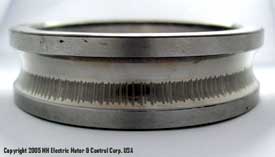To talk in general about factors that may cause contact between rotor and stator:
1 - Poor initial centering.
2 - Wear at housing ID.
3 - Wear internal to the bearing.
4 – Rotor bending (result of unbalanced magnetic pull or operating near flexible rotor critical). I tend to discount this cause for your case because the rub was near the end of the machine rather than the center.
5 – Small airgap by design can make machine more susceptible to small variations above.
It doesn’t seem we have full info available. You’ve mentioned “motors’ many times. It’s not clear how many motors have rubbed and which symptoms are seen on those that rub.
A methodical approach would be to take a motor that rubbed and do some checks:
1 – Before even disassembling the motor, push pull on the rotor shaft extention and measure shaft movement radially with dial indicator. This is just extra info
2 - Remove rotor from stator but don’t remove bearings from rotor.
3 - Measure bearing internal clearance in radial direction. i.e. with bearings still mounted on rotor, push/pull on the bearing and measure movement in both directions with dial indicator (rotor solidly mounted on test fixture to prevent movement).
4 – Measure bearing OD. *
5 – Measure housing ID. *
* to be thorough, stand procedure would be to explore variability with 6 measurements: 3 angular locations (60 degrees apart) and 2 axial locations (1/4 distance in from each end).
6 – Measure rotor ID in vicninity of the rub. 3 locations 90 degrees apart. Measure at other locations for comparison.
7 – measure stator bore in the vicinity fof the rub. Measure at other locations for comparison.
8 – Attempt to determine deviation from concentricity of housing bore and stator bore. This is tough for a number of reasons and certainly complicated by rough geometry of stator bore. I’d talk to my machine shop about what they can do. Some options:
8A – with drive end endbell mouted to stator: Put on mill capable of rotating both. Center the fixture using one surface and indicate off the other surface.
with drive end endbell mouted to stator: with drive end endbell mouted to stator:
8B – with drive end endbell mouted to stator: use 3Dcoordinate measuring device.
8C – if cannot do either of above, might measure stator and endbell separately, comparing each one to the rabbet fit of endbell to stator.
With above info, you should have a good basis for making a determination.
If the cause does not jump out at you, you can take similar measurements at the ODE for comparison to help highlight measurements that are out of whack on the DE.
=====================================
(2B)+(2B)' ?

![[2thumbsup] [2thumbsup] [2thumbsup]](/data/assets/smilies/2thumbsup.gif)
